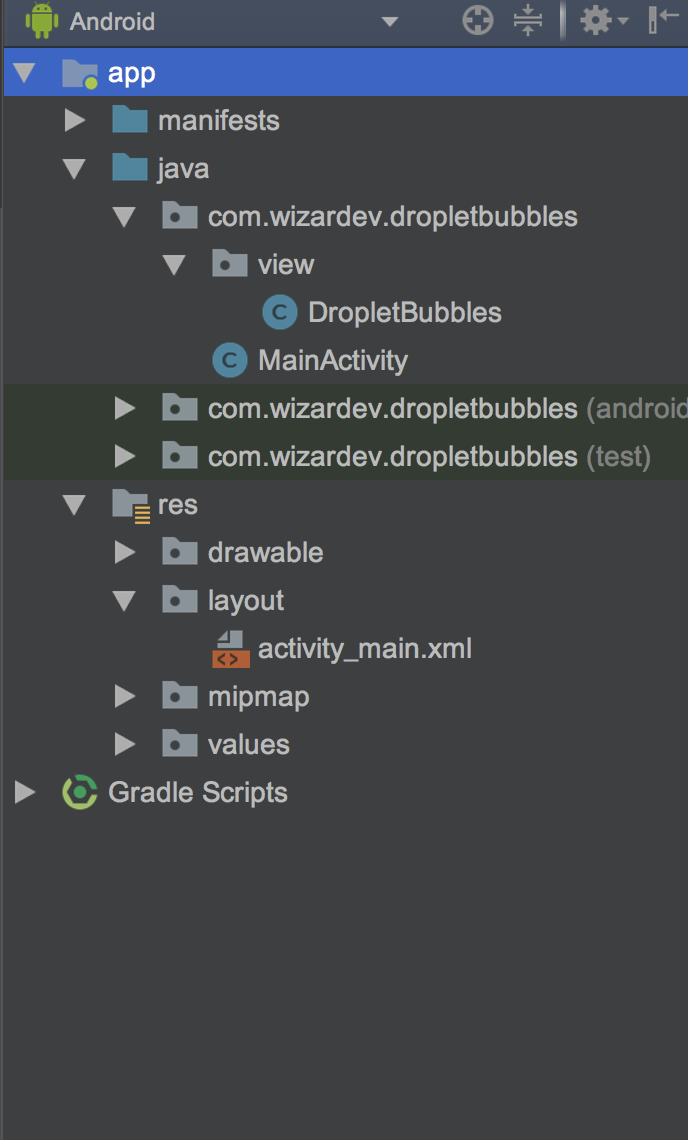Android自定义水波气泡
前言:公司在做的一个项目,要求在地图上以水波气泡的形式来显示站点,并且气泡要有水波的动态效果。好吧!既然有这样的需求,那就手撸一款水波气泡吧!
效果图预览
最后完成的效果图如下
实现方式
步骤拆解
在需要自定义view的时候,我首先要做的就是将最后要实现的效果来进行拆分,拆分成许多小的步骤,然后一步步的来实现,最终达到想要的效果。
可以将文章开始的时候的效果图拆分成以下几部分:
- 画出气泡后面的白色背景。
- 画内部的紫色气泡。
- 用贝塞尔曲线让内部的紫色气泡动起来。
拆解之后,就可以按照拆解的步骤来一步步实现了。
画白色背景
这里画白色背景有以下两种方式:
- 用
path直接描述一个白色背景的形状。 - 用
path描述一个三角形,然后在画出一个圆形,即成最终的白色背景了。
第一种方式如下图的左图,用path直接描述出了白色背景,这种方式可以用path.addArc()来画上部弧形,然后用path.moveTo()和path.lineTo()方法描述出下部分的尖角。
第二种实现的方式如下图的右图,直接画出一个圆,再用path.moveTo()和path.lineTo()方法来描述出下部分的尖角。
本文采用的是第二种方式来实现的,具体代码如下
//此处代码是下部尖角的path
mBackgroundPath.moveTo(mResultWidth / 2 - mOutRadius / 2, mResultWidth / 2 + mOutRadius / 2);
mBackgroundPath.lineTo(mResultWidth / 2, mResultWidth / 2 + mOutRadius + mOutRadius / 4);
mBackgroundPath.lineTo(mResultWidth / 2 + mOutRadius / 2, mResultWidth / 2 + mOutRadius / 2);
//画外部背景
canvas.drawPath(mBackgroundPath, mBackgroundPaint);
canvas.drawCircle(mResultWidth / 2, mResultWidth / 2, mOutRadius, mBackgroundPaint);
画内部的气泡
内部的气泡的形状其实就是缩小的外部背景,具体的代码如下
//内部气泡的尖角
mBubblesPath.moveTo(mResultWidth / 2 - mOutRadius / 2, mResultWidth / 2 + mOutRadius / 2 - dp2px(getContext(), 5));
mBubblesPath.lineTo(mResultWidth / 2, mResultWidth / 2 + mOutRadius + mOutRadius / 4 - dp2px(getContext(), 5));
mBubblesPath.lineTo(mResultWidth / 2 + mOutRadius / 2, mResultWidth / 2 + mOutRadius / 2 - dp2px(getContext(), 5));
//画圆
mBubblesPath.addCircle(mResultWidth / 2, mResultWidth / 2, mInnerRadius, Path.Direction.CCW);
到这里已经将气泡的基本形状画出来了,见下图
我们会发现气泡内部的颜色是渐变色,那渐变色是怎么设置的呢?其实自定义view就是将想要的效果通过画笔画在画布上,实现颜色的渐变肯定就是通过设置画笔的属性来实现的了,设置渐变色的代码如下
//设置渐变色
Shader shader = new LinearGradient(mResultWidth / 2, mResultWidth / 2 - mInnerRadius, mResultWidth / 2, mResultWidth / 2 + mInnerRadius, Color.parseColor("#9592FB"),
Color.parseColor("#3831D4"), Shader.TileMode.CLAMP);
mBubblesPaint.setShader(shader);
LinearGradient(float x0, float y0, float x1, float y1, @ColorInt int color0, @ColorInt int color1, @NonNull TileMode tile)
x0y0x1y1:渐变的两个端点的位置color0color1是端点的颜色tile:端点范围之外的着色规则,类型是TileMode。TileMode一共有 3 个值可选:CLAMP,MIRROR和REPEAT。一般用CLAMP就可以了。
让内部气泡动起来
气泡内部的动画是水波的形式,这里画水波用的是二阶贝塞尔曲线,关于Android中贝塞尔曲线的知识可以参考这里。实现气泡内部水波效果的代码如下
/**
* 核心代码,计算path
*
* @return
*/
private Path getPath() {
int itemWidth = waveWidth / 2;//半个波长
Path mPath = new Path();
mPath.moveTo(-itemWidth * 3, baseLine);//起始坐标
Log.d(TAG, "getPath: " + baseLine);
//核心的代码就是这里
for (int i = -3; i < 2; i++) {
int startX = i * itemWidth;
mPath.quadTo(
startX + itemWidth / 2 + offset,//控制点的X,(起始点X + itemWidth/2 + offset)
getWaveHeight(i),//控制点的Y
startX + itemWidth + offset,//结束点的X
baseLine//结束点的Y
);//只需要处理完半个波长,剩下的有for循环自已就添加了。
}
Log.d(TAG, "getPath: ");
//下面这三句话是行程封闭的效果,不明白可以将下面3句代码注释看下效果的变化
mPath.lineTo(width, height);
mPath.lineTo(0, height);
mPath.close();
return mPath;
}
//奇数峰值是正的,偶数峰值是负数
private float getWaveHeight(int num) {
if (num % 2 == 0) {
return baseLine + waveHeight;
}
return baseLine - waveHeight;
}
上面的代码画出的水波如下图
到这里已经画出了水波,但现在水波还是静止的,要让水波不停的移动,就要添加属性动画,添加动画的代码如下
/**
* 不断的更新偏移量,并且循环。
*/
public void updateXControl() {
//设置一个波长的偏移
ValueAnimator mAnimator = ValueAnimator.ofFloat(0, waveWidth);
mAnimator.setInterpolator(new LinearInterpolator());
mAnimator.addUpdateListener(new ValueAnimator.AnimatorUpdateListener() {
@Override
public void onAnimationUpdate(ValueAnimator animation) {
float animatorValue = (float) animation.getAnimatedValue();
offset = animatorValue;//不断的设置偏移量,并重画
postInvalidate();
}
});
mAnimator.setDuration(1800);
mAnimator.setRepeatCount(ValueAnimator.INFINITE);
mAnimator.start();
}
修改一下onDraw中的代码,如下
@Override
protected void onDraw(Canvas canvas) {
super.onDraw(canvas);
mBubblesPath.reset();
//设置渐变色
Shader shader = new LinearGradient(mResultWidth / 2, mResultWidth / 2 - mInnerRadius, mResultWidth / 2, mResultWidth / 2 + mInnerRadius, Color.parseColor("#9592FB"),
Color.parseColor("#3831D4"), Shader.TileMode.CLAMP);
mBubblesPaint.setShader(shader);
//此处代码是下部尖角的path
mBackgroundPath.moveTo(mResultWidth / 2 - mOutRadius / 2, mResultWidth / 2 + mOutRadius / 2);
mBackgroundPath.lineTo(mResultWidth / 2, mResultWidth / 2 + mOutRadius + mOutRadius / 4);
mBackgroundPath.lineTo(mResultWidth / 2 + mOutRadius / 2, mResultWidth / 2 + mOutRadius / 2);
//内部气泡的尖角
mBubblesPath.moveTo(mResultWidth / 2 - mOutRadius / 2, mResultWidth / 2 + mOutRadius / 2 - dp2px(getContext(), 5));
mBubblesPath.lineTo(mResultWidth / 2, mResultWidth / 2 + mOutRadius + mOutRadius / 4 - dp2px(getContext(), 5));
mBubblesPath.lineTo(mResultWidth / 2 + mOutRadius / 2, mResultWidth / 2 + mOutRadius / 2 - dp2px(getContext(), 5));
//画外部背景
canvas.drawPath(mBackgroundPath, mBackgroundPaint);
canvas.drawCircle(mResultWidth / 2, mResultWidth / 2, mOutRadius, mBackgroundPaint);
Log.d(TAG, "cx: " + mResultWidth / 2);
//画水波
mBubblesPath.addCircle(mResultWidth / 2, mResultWidth / 2, mInnerRadius, Path.Direction.CCW);
canvas.drawPath(getPath(), mBubblesPaint);
}
好了,现在水波已经可以移动了,看下效果
what!怎么成这个样子了呀,明显不是我想要的效果呀,肯定是哪里出错了,经过我仔细的推敲,总结了出现上面问题的原因,原因如下图
出现上面问题的原因就是因为下面三句代码
mPath.lineTo(width, height);
mPath.lineTo(0, height);
mPath.close();
知道是这三句代码的原因,那应该怎么修改呢?这三句代码好像不能动,不然就会出现波浪画的不完整的情况,额.....,那应该修改哪里呢?灵光一闪,不是可以裁剪画布嘛,只要将画布裁剪成想要的形状,然后在画波浪不久完美了。再修改onDraw方法,修改后的代码如下
@Override
protected void onDraw(Canvas canvas) {
super.onDraw(canvas);
mBubblesPath.reset();
//设置渐变色
Shader shader = new LinearGradient(mResultWidth / 2, mResultWidth / 2 - mInnerRadius, mResultWidth / 2, mResultWidth / 2 + mInnerRadius, Color.parseColor("#9592FB"),
Color.parseColor("#3831D4"), Shader.TileMode.CLAMP);
mBubblesPaint.setShader(shader);
//此处代码是下部尖角的path
mBackgroundPath.moveTo(mResultWidth / 2 - mOutRadius / 2, mResultWidth / 2 + mOutRadius / 2);
mBackgroundPath.lineTo(mResultWidth / 2, mResultWidth / 2 + mOutRadius + mOutRadius / 4);
mBackgroundPath.lineTo(mResultWidth / 2 + mOutRadius / 2, mResultWidth / 2 + mOutRadius / 2);
//内部气泡的尖角
mBubblesPath.moveTo(mResultWidth / 2 - mOutRadius / 2, mResultWidth / 2 + mOutRadius / 2 - dp2px(getContext(), 5));
mBubblesPath.lineTo(mResultWidth / 2, mResultWidth / 2 + mOutRadius + mOutRadius / 4 - dp2px(getContext(), 5));
mBubblesPath.lineTo(mResultWidth / 2 + mOutRadius / 2, mResultWidth / 2 + mOutRadius / 2 - dp2px(getContext(), 5));
//画外部背景
canvas.drawPath(mBackgroundPath, mBackgroundPaint);
canvas.drawCircle(mResultWidth / 2, mResultWidth / 2, mOutRadius, mBackgroundPaint);
Log.d(TAG, "cx: " + mResultWidth / 2);
//切割画布,画水波
canvas.save();
mBubblesPath.addCircle(mResultWidth / 2, mResultWidth / 2, mInnerRadius, Path.Direction.CCW);
//将画布裁剪成内部气泡的样子
canvas.clipPath(mBubblesPath);
canvas.drawPath(getPath(), mBubblesPaint);
canvas.restore();
}
到这里已经实现了文章开始时的效果了,文章也该结束了。
项目结构

结束语
本文主要是讲解怎样实现水波气泡,并没有讲到View的测量,贴出的也只是绘制气泡的代码,完整的代码可以点击这里获取。
虽然已经撸出了这个效果,但最后项目中并没有用这种动态的气泡,因为气泡多的时候是在是卡……。最后,喜欢此demo,就随手给个star吧!手撸一款精美的水波气泡
注:本文著作权归作者,由demo大师代发,拒绝转载,转载需要作者授权